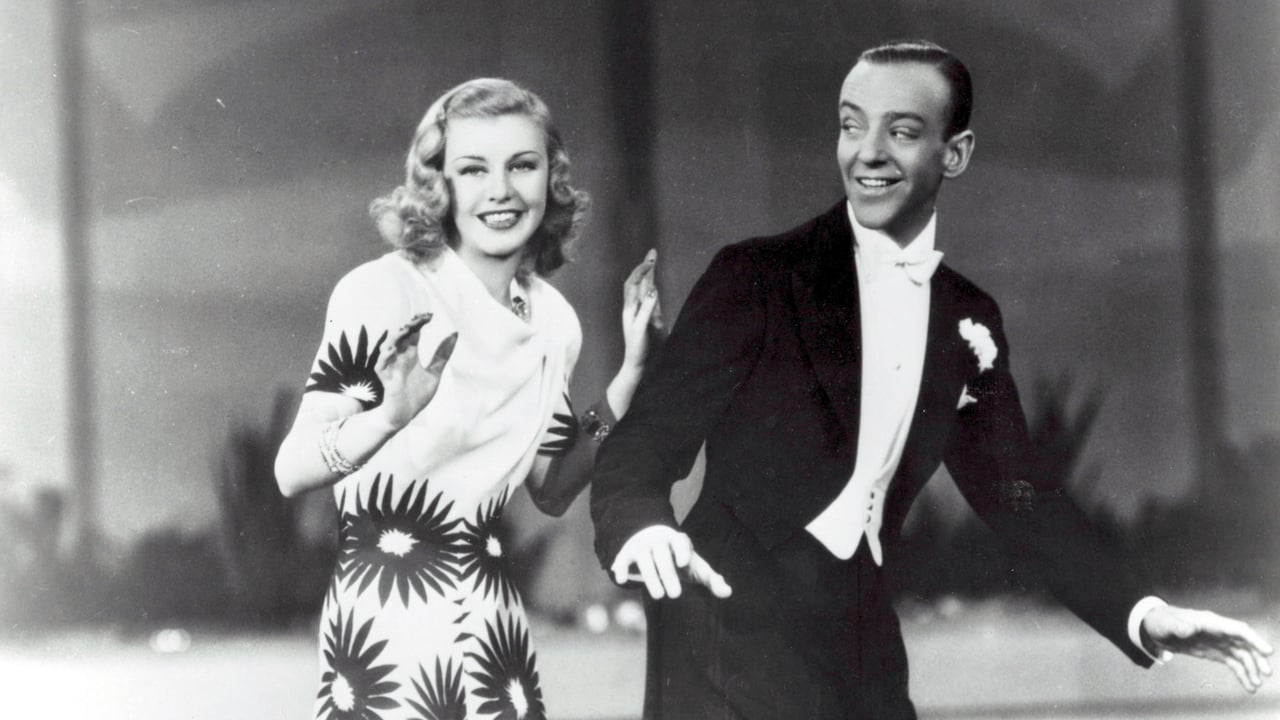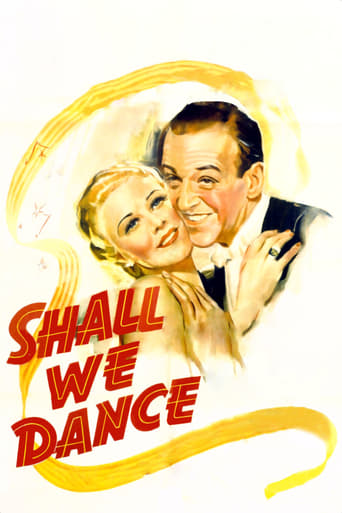

It is a performances centric movie
... View MoreThe best films of this genre always show a path and provide a takeaway for being a better person.
... View MoreThe movie's not perfect, but it sticks the landing of its message. It was engaging - thrilling at times - and I personally thought it was a great time.
... View MoreIt is interesting even when nothing much happens, which is for most of its 3-hour running time. Read full review
... View MoreSomewhere I read that you'll think more highly of the Astaire/Rogers SHALL WE DANCE if it's the first of their movies that you've seen. Watching them in order leaves you with the impression that we've seen all this before, and what's more, that we've seen it all done better before as well.Unquestionably the great strength of the film is its musical score, by my count the fifth great musical score in a row for the series, but I'd have to agree with George Gershwin that it wasn't used very well. The main problem: Ginger and Fred don't dance together enough. Indeed, they only have one major duet in the whole movie, danced to 'They All Laughed'. It's a dandy, but even here they'd done comparable dances even more brilliantly in ROBERTA, TOP HAT AND SWING TIME. Of course, they also roller skate, and practically everyone adores the scene so who am I to knock it? Nevertheless, I miss them dancing, and the final duet to the title song comes and goes in about 30 seconds and only whets my appetite for more.After giving possibly the best performance in the entire series in SWING TIME, Ginger Rogers seems off here, irritable practically from beginning to end and considerably less fun than she was in the rest of the series (and during practically the rest of her career). The fact that she was the victim of an extortion attempt during the film's shooting may have had something to do with it. For those interested, she received a note demanding $50,000 or else they would kill Ginger's mother. Turning it over to the FBI, the fellow was apprehended at the scheduled drop point and turned out to be a sailor who was simply after the money, not the mother. He'd chosen Ginger because she was his favorite actress!But getting back to the movie, unlike in the rest of the series the songs are generally ill-fitted into the plot. While it's not unusual for Fred's solo to be a simple exhibition of his dancing ability that has little to do with the rest of the film, it is unusual for their major duets to move the plot exactly nowhere. As John Mueller points out in ASTAIRE DANCES, during the marvelous dance to 'They All Laughed', Ginger's character seems to be loosening up emotionally and moving closer to Fred's, the typical character movement in their up tempo numbers, but here she simply reverts to exactly where she had been before, i.e., simply resentful towards him. It's as if the dance had never happened. And what her motivation was for the reconciliation dance at the end I'll never understand. Would you be attracted to someone dancing with people wearing masks of you? I'd more likely call the nearest mental hospital.Speaking of motivation, what exactly would possess Fred to suddenly play hard to get once Ginger had finally invited him into her apartment on their wedding night? It did lead to probably the most artful shot that Mark Sandrich devised in the entire series (the one of them both hesitating before opposite sides of the door between them), but still...Ah, I'm sure I'm being too hard on SHALL WE DANCE. It's an elaborate production featuring two great performers, a few laughs, and terrific music. Who could ask for anything more?
... View MoreShall We Dance (1937) *** 1/2 (out of 4) The seventh teaming of Fred Astaire and Ginger Rogers has him playing a Russian ballet and her a tap-dancer. The two of them really get to know one another while on a boat heading for America but somehow word gets out that they're married, which sets off a firestorm in New York and gives them unwanted attention. SHALL WE DANCE is without question a very good film but there's no doubt that it's lacking some originality. Previous teamings of the two stars pretty much had the same story. They meet. He annoys her. She falls for him. He falls for her. There's a mistake which causes problems. That same story structure is pretty much followed here and there's no question that it's quite predictable by now but at the same time there's no question that the two stars and their supporting players are in fine form and manage to make it work. There are several good moments here but I'd say the highlight is the roller skating sequence where the always impressive duo makes one even more aware of their genius. I'm not sure how long it took them to perfect this dance sequence but it's certainly a very impressive one that ranks among their best work. The Gershwin songs are all pretty good in their one way but "Let's Call the Whole Thing Off" is certainly the highlight. As I said, both Astaire and Rogers are perfect together as there's never a doubt that their chemistry seems real. Edward Everett Horton is on hand and offers up his usual nice comic timing. SHALL WE DANCE is certainly going to appeal to those fans of Astaire and Rogers even though it does fall short of TOP HAT and SWING TIME.
... View MoreFirst of all, Fred Astaire is far too American to be believable as a Russian dancer named "Petrov", and the squabbling he goes through with Ginger Rogers (as an off-key star of musical revues) is a repeat of everything that they've done in their movies up until now. But when you've got Edward Everett Horton, Eric Blore and RKO's top art decco set directors, that's enough to distract you from the silliness of the plot. Add on songs by the Gershwins (the first of two films where they collaborated together) and all those reluctant complaints seem redundant.The basic plot has Astaire and Rogers being mistaken in the press as married, and before you know it, they're hotter than Brad and Angelina. Ginger wants no part of this, but Freddie has a few tricks up his sleeve to win her for good. Thanks to George and Ira's music (some of George's last), it works. Fred woos her to "They Can't Take That Away From Me" (which he would repeat 12 years later in "The Barkleys of Broadway") and even has a bunch of dancers with Ginger masks prancing around him in the title number. What tough Broadway star wouldn't fall for that? The lyrics for Ira are very clever too, particularly in "They All Laughed" and "Let's Call the Whole Thing Off". As visually exciting as the ship set song "Let Yourself Go" is, what boiler room looks like a Broadway set? Horton & Blore provide droll humor, and exchange some great lines. All they are missing is Franklin Pangborn.
... View MoreAfter "The Gay Divorcée," the first starring vehicle for Astaire and Rogers, established the formula of breezy mixture of musical numbers and comedy, the duo kept appearing in films that varied the formula only slightly, and so it goes here. This one features the music of Gershwin, including "Let's Call the Whole Thing Off," "They All Laughed," and "They Can't Take That Away from Me," and Horton and Blore once again provide the laughs. It's pleasant enough, but falls short compared to the likes of "Top Hat" and "Swing Time." While the roller skate routine is fun, this one lacks a signature number. The script is uninspired and the comedy is forced.
... View More